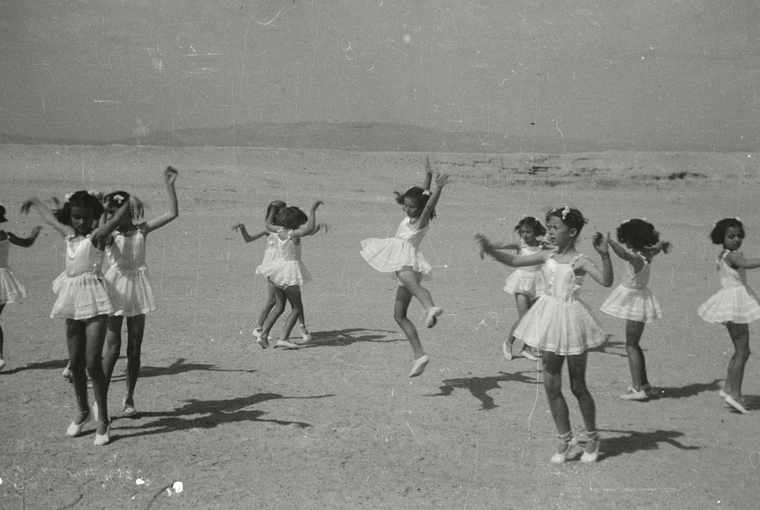From Dalmatia to the Desert
Ivan Ramljak’s El Shatt – A Blueprint for Utopia (El Shatt – nacrt za utopiju, 2023)
Vol. 139 (November 2023) by Zoe Aiano
In 1943, Italian forces withdrew from the Croatian region of Dalmatia, leaving the population ostensibly free but in reality at strong risk of retaliation from the Germans. This threat was especially high for families known to be associated with the Partisan movement, and as such Tito ordered the evacuation of the entire non-combatant population. This group amounting to tens of thousands of people, it was difficult to find somewhere big enough to accommodate them. The solution eventually settled on was El Shatt, a remote desert area of Egypt, where these refugees created a camp that would become their home for the next two years. In the feature documentary El Shatt – A Blueprint for Utopia, director Ivan Ramljak seeks to compensate for the shocking lack of attention this remarkable story has received since the fall of Yugoslavia by telling it from the first-hand perspective of those who lived through it.
The film opens with a long, slow sequence depicting a day in the life of the caretaker charged with tending to the cemetery for those who died at El Shatt during the war. Despite being obviously very isolated in terms of both the geography itself and the lack of visitors – the only passing traffic shown is a cargo ship loaded with containers sailing up the nearby canal – the graves are meticulously maintained. The attendant is shown not only watering the plants and doing general cleaning, but also meticulously re-painting the many names carved into the memorial slabs. The whole thing has a surreal overtone, as if the caretakers are keeping the site neat for Godot.
Following this, the format shifts to actors warming up, dressed in Yugoslav partisan garb. Straddling time periods by clearly belonging in the current day but speaking of the war in the present tense, they go on to lay out the historical context through the theatrical monologues, combining information with a dramatic delivery that sets up the suspense of the narrative about to unfurl. These actors are, in fact, replicating a traditional form of political propaganda in the style of a “talking newspaper”. They reappear periodically to break up the thematic blocks and describe significant events taking place in the global sphere.
The film’s third, and predominant, language is the classic montage of film and photographic archives, with a voiceover provided by interviewees giving first-hand accounts of their experiences, first on the arduous journey to reach El Shatt, and then on daily life within the camp itself. None of the protagonists are clearly identified, the dialog jumping from one to the next thematically rather than chronologically or by character. Through a series of anecdotes, we are given a glimpse of daily life, from the food the refugees ate to the clothing that they wore, from the illnesses they caught to the romances that blossomed. Beyond this, a lot of space is given to the organization and political framework underpinning the camp, with descriptions of all the many reports, bulletins and newspapers being produced, as well as the never-ending meetings. The film treads a careful line that avoids glorifying what must have been a very grueling existence while still showing respect for the impressive way in which the whole situation was handled. Clearly, life in the camp was far from banal thanks to the provision of classes, groups, and community activities, yet diseases and pests were also rampant, and the vast cemetery testifies to the fragility of life.
The visuals also don’t pick out any particular characters, but they do cover quite an extraordinary breadth of activities and events, managing to directly illustrate a surprising amount of the experiences being described. While no mention is made of the origin of these images, they tacitly speak to a politically savvy organization that was aware of the importance of documentation and propaganda. The ideological agenda of the film is actually less prominent than the film’s title would suggest. Of course, traces of Socialism are found throughout: it was a Socialist project, and one of the protagonists makes a point of giving credit to the underlying party infrastructure for allowing the camp to function so effectively and so immediately. Nevertheless, the film is not entirely uncritical, describing an instance of a woman being kicked out of the movement for questioning its approach, for example, and the core of the film remains the chronicling of a historical period from an individual perspective. That said, the mere decision to make this film and tell this story has political implications, given the Croatian government’s tendency to suppress memories of Yugoslavia, especially positive ones.
Beyond this national perspective, however, the film also incorporates a significant internationalist outlook. Despite being in the desert, the camp and its inhabitants were not disconnected from the world. The interviewees tell of their interactions with Allied forces and locals, noting the massive hierarchical imbalance between the two and the general mistreatment of the Egyptians by the British. Indeed, this was far from the only camp – not only was a rival Croatian Chetnik camp located nearby, several other Western nations had their own camps in the region. Together with this periodic return to El Shatt as it is in the present day, this situates the story poignantly as not only belonging to Yugoslavia but to the world. As such, through this well-crafted and highly engaging piece of documentation, Ivan Ramljak is not only filling in a gap of regional history but of global history, at a time when it is ever more important to remember how interconnected we all are.




Leave a Comment